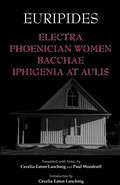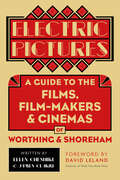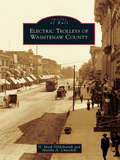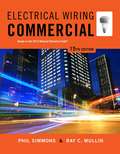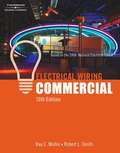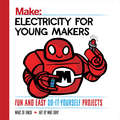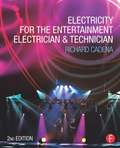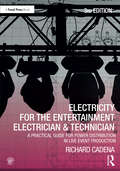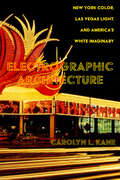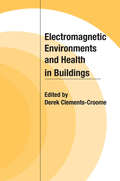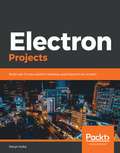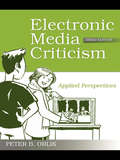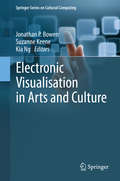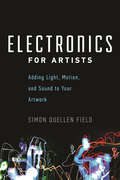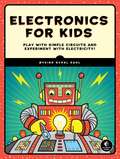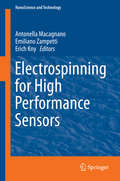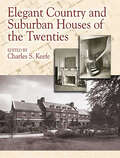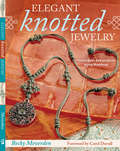- Table View
- List View
Electra, Phoenician Women, Bacchae, and Iphigenia at Aulis
by Euripides Paul Woodruff Cecelia Eaton LuschnigThe four late plays of Euripides collected here, in beautifully crafted translations by Cecelia Eaton Luschnig and Paul Woodruff, offer a faithful and dynamic representation of the playwright’s mature vision.
Electric Dreamland: Amusement Parks, Movies, and American Modernity (Film and Culture Series)
by Lauren RabinovitzAmusement parks were the playgrounds of the working class in the early twentieth century, combining numerous, mechanically-based spectacles into one unique, modern cultural phenomenon. Lauren Rabinovitz describes the urban modernity engendered by these parks and their media, encouraging ordinary individuals to sense, interpret, and embody a burgeoning national identity. As industrialization, urbanization, and immigration upended society, amusement parks tempered the shocks of racial, ethnic, and cultural conflict while shrinking the distinctions between gender and class. Following the rise of American parks from 1896 to 1918, Rabinovitz seizes on a simultaneous increase in cinema and spectacle audiences and connects both to the success of leisure activities in stabilizing society. Critics of the time often condemned parks and movies for inciting moral decline, yet in fact they fostered women's independence, racial uplift, and assimilation. The rhythmic, mechanical movements of spectacle also conditioned audiences to process multiple stimuli. Featuring illustrations from private collections and accounts from unaccessed archives, Electric Dreamland joins film and historical analyses in a rare portrait of mass entertainment and the modern eye.
Electric Kiln Ceramics: Third Edition
by Richard ZakinOver the last decade, the safety, convenience and comparative cleanliness of the electric kiln have made it popular with studio potters and ceramicists. This book is designed to help the ceramicist to make the most of the electric kiln. It contains reviews of clays, glazes and techniques developed exclusively for the electric kiln. The book begins with an introduction to the kiln and the various clays and glazes best suited to its use. Both commercial and homemade clays are discussed and recipes are provided for slips and glazes for different firing temperatures. Special glazes, the application of oxidation surfaces and loading and firing are explored in depth. This second edition is illustrated with all new photographs of the work of an international group of artists. the book also contains health and safety information. Richard Zakin has also written "Ceramics: Mastering the Craft".
Electric Pictures: A Guide to the Films, Film-Makers & Cinemas of Worthing & Shoreham
by James Clarke Ellen Cheshire David LelandWritten as part of the Worthing WOW festival celebrations, Electric Pictures commemorates 120 years of film in the Sussex coastal towns of Worthing and Shoreham, capturing the region’s rich cinematic legacy and its place in British film history. From film-making pioneers through to blockbuster films and key events in the film history of the coast, this volume draws on research from film archives and local history resources to tell the story of the south coast film world. Richly illustrated and featuring contributions from local historians and film and theatre specialists, this book also includes an additional Heritage Trail guide that reveals key filming locations and the towns’ cinemas.
Electric Sounds: Technological Change and the Rise of Corporate Mass Media
by Stephen WurtzlerA history of sound recording and reproduction and how this technology transformed American mass media.
Electric Sounds: Technological Change and the Rise of Corporate Mass Media (Film and Culture Series)
by Steve WurtzlerElectric Sounds brings to vivid life an era when innovations in the production, recording, and transmission of sound revolutionized a number of different media, especially the radio, the phonograph, and the cinema. The 1920s and 1930s marked some of the most important developments in the history of the American mass media: the film industry's conversion to synchronous sound, the rise of radio networks and advertising-supported broadcasting, the establishment of a federal regulatory framework on which U.S. communications policy continues to be based, the development of several powerful media conglomerates, and the birth of a new acoustic commodity in which a single story, song, or other product was made available to consumers in multiple media forms and formats.But what role would this new media play in society? Celebrants saw an opportunity for educational and cultural uplift; critics feared the degradation of the standards of public taste. Some believed acoustic media would fulfill the promise of participatory democracy by better informing the public, while others saw an opportunity for manipulation. The innovations of this period prompted not only a restructuring and consolidation of corporate mass media interests and a shift in the conventions and patterns of media consumption but also a renegotiation of the social functions assigned to mass media forms. Steve J. Wurtzler's impeccably researched history adds a new dimension to the study of sound media, proving that the ultimate form technology takes is never predetermined. Rather, it is shaped by conflicting visions of technological possibility in economic, cultural, and political realms. Electric Sounds also illustrates the process through which technologies become media and the ways in which media are integrated into American life.
Electric Trolleys of Washtenaw County (Images of Rail)
by H. Mark Hildebrandt Martha A. ChurchillElectric streetcars and interurbans appeared in Washtenaw County in the 1890s. Evolved from horse-drawn streetcars, electric cars were ideal for public transportation. They were cheap, fast, and went to plenty of places. The system developed around Ann Arbor and Ypsilanti, branching out to Detroit to the east and Jackson to the west. Bigger and better equipment was added, and larger companies took over the small ones. In western Washtenaw County, two interurban railways engaged in a struggle for survival. Occasionally the interurbans crashed into buildings or one another, with disastrous results. Electric Trolleys of Washtenaw County explains how electric mass transportation flourished starting in the 1890s, why it bloomed, and why it suddenly became extinct after only a few decades.
Electrical Wiring Commercial
by Ray C. Mullin Phil SimmonsOffering the most current coverage available, ELECTRICAL WIRING COMMERCIAL, 15e is completely revised and up to date with the 2014 National Electrical Code. Extremely reader friendly, the text has long been popular with learners. Vibrant, full-color illustrations and photographs help you easily grasp difficult concepts. The new edition continues the book's emphasis on newer green technologies and developments within electrical design and installation, including coverage of EV stations in commercial settings. It also offers expansive coverage of safety in the workplace.
Electrical Wiring Commercial
by Ray C. Mullin Phil SimmonsCompletely revised and up to date with the 2017 National Electrical Code#65533;, ELECTRICAL WIRING COMMERCIAL, Sixteenth Edition, offers the most current coverage available. This reader-friendly text has long been trusted by instructors and popular with students. Known for its vibrant, full-color illustrations and photographs, the text bring even difficult concepts to life and makes complex material easier to understand. In addition to updates based on 2017 NEC#65533;, the Sixteenth Edition features increased emphasis on green technologies, new developments in electrical design and installation, and safety in the workplace, providing ample coverage of topics you'll likely encounter as a working professional in this dynamic field.
Electrical Wiring Commercial
by Ray C. Mullin Robert L. SmithThis introduction to basic wiring centers on the planning of a typical commercial electrical installation, demonstrating how the load requirements are converted into branch-circuit, then into feeders, and finally into the building's main electrical service. Ten plan sheets are provided. The eleventh edition of the textbook adds a comparison of armored cable to metal clad cable. Annotation c. Book News, Inc. , Portland, OR (booknews. com)
Electricity for Young Makers: Fun and Easy Do-It-Yourself Projects
by Marc De VinckLearning to be a maker has never been more fun. Lavishly illustrated with cartoons and drawings, this book guides the reader through six hands-on projects using electricity. Discover the electrical potential lurking in a stack of pennies - enough to light up an LED or power a calculator! Launch a flying LED copter into the air. Make a speaker that plays music from an index card. Build working motors from a battery, a magnet, and some copper wire. Have fun while learning about and exploring the world of electricity. The projects in this book illuminate such concepts as electric circuits, electromagnetism, electroluminescence, the Lorentz force and more. You'll be amazed by the results you get with a handful of simple materials.
Electricity for the Entertainment Electrician & Technician
by Richard CadenaThe application of electricity for the theatre or a concert stage is not the same as for a residence or commercial building. Electricity for the Entertainment Electrician & Technician provides you with the fundamentals of theory of electricity as well as the latest guidelines and tips for how to stay safe, current and meet the needs of the entertainment industry. Written by an ETCP (Entertainment Technician Certification Program) trainer this reference supports practicing technicians and provides new technicians the assistance needed for a successful career in the entertainment industry. * The only reference on electricity for the entertainment industry professional!* Written by an ETCP (Entertainment Technician Certification Program) trainer and seasoned professional* Free additional practice problems and animations at www.electricityentertainmenttech.com
Electricity for the Entertainment Electrician & Technician: A Practical Guide for Power Distribution in Live Event Production
by Richard CadenaNow in its third edition, Electricity for the Entertainment Electrician & Technician is a comprehensive, practical study guide for aspiring and working professionals in live event production. The book covers every aspect of power distribution from the fundamentals, like basic circuits, to 3-phase power, power calculations, grounding and bonding, electrical safety, portable power generators, and battery power. With ample photographs and illustrations, practice problems and solutions, and real-world examples from experience and first-hand accounts, it provides readers with the knowledge to safely design, set up, and monitor power distribution systems. The third edition expands on grounding and bonding, portable power generators, balanced and unbalanced 3-phase power calculations, battery power, and more. The last chapter walks readers through the process of prepping for a show, setting up a portable power distribution system, and monitoring every aspect of the system, including voltage, current, and heat using an infrared camera, explaining in detail best practices and the logic behind them. Covering topics that are listed in the content outline for the ETCP Entertainment Electrician Certification exam as well as the ETCP Portable Power Distribution Technician Certification exam, this reference supports practicing technicians and provides new technicians the assistance they need for a successful career in the entertainment industry. Additional resources, including conversion tables, voltage spreadsheets, articles from Lighting & Sound International, Lighting & Sound America, and Protocol, and animations and illustrations depicting electricity and electric power distribution developed for the author’s workshops, can be found on the companion website www.electrics.tech.
Electricity for the Entertainment Electrician & Technician: A Practical Guide for Power Distribution in Live Event Production
by Richard CadenaNow in its third edition, Electricity for the Entertainment Electrician & Technician is a comprehensive, practical study guide for aspiring and working professionals in live event production.The book covers every aspect of power distribution from the fundamentals, like basic circuits, to 3-phase power, power calculations, grounding and bonding, electrical safety, portable power generators, and battery power. With ample photographs and illustrations, practice problems and solutions, and real-world examples from experience and first-hand accounts, it provides readers with the knowledge to safely design, set up, and monitor power distribution systems. The third edition expands on grounding and bonding, portable power generators, balanced and unbalanced 3-phase power calculations, battery power, and more. The last chapter walks readers through the process of prepping for a show, setting up a portable power distribution system, and monitoring every aspect of the system, including voltage, current, and heat using an infrared camera, explaining in detail best practices and the logic behind them.Covering topics that are listed in the content outline for the ETCP Entertainment Electrician Certification exam as well as the ETCP Portable Power Distribution Technician Certification exam, this reference supports practicing technicians and provides new technicians the assistance they need for a successful career in the entertainment industry.Additional resources, including conversion tables, voltage spreadsheets, articles from Lighting & Sound International, Lighting & Sound America, and Protocol, and animations and illustrations depicting electricity and electric power distribution developed for the author’s workshops, can be found on the companion website www.electrics.tech.
Electrographic Architecture: New York Color, Las Vegas Light, and America's White Imaginary
by Prof. Carolyn L. KaneBridging histories of technology, media studies, and aesthetics, Electrographic Architecture forges a critical narrative of the ways in which illuminated light and color have played key roles in the formation of America's white imaginary. Carolyn L. Kane charts the rise of the country's urban advertisements, light empires, and neoclassical buildings in the early twentieth century; the midcentury construction of polychromatic electrographic spectacles; and their eclipse by informatically intense, invisible algorithms at the dawn of the new millennium. Drawing on archival research, interviews, and visual analysis, Electrographic Architecture shows how the development of America's electrographic surround runs parallel to a new paradigm of power, property, and possession.
Electromagnetic Environments and Health in Buildings
by Derek Clements-CroomeWith increasing use of mobile phones and VDUs, levels of background radiation and electromagnetism are rising, particularly in the workplace and also in the home. To some extent this is unavoidable, but the level of dangers is unclear: is it trivially small, moderate or high? What are the risks of illness, and how can these be reduced to minimal or tolerable levels? Are some people more vulnerable than others? What can or should employers, building engineers and designers, product designers, workers and other members of the public do?This book, of which the chapters derive from presentations given by distinguished authorities at a major international conference, aims to present sound technical information on the whole range of key issues in a clear and accessible way.
Electron Projects: Build over 9 cross-platform desktop applications from scratch
by Denys VuikaThe book aims at JavaScript developers who want to explore the Electron framework for building desktop apps. The book assumes working knowledge with modern front-end JS frameworks and Node.js. No prior knowledge of desktop development required.
Electronic Media Criticism: Applied Perspectives (3rd Edition)
by Peter B. OrlikElectronic Media Criticism introduces readers to a variety of critical approaches to audio and video discourse on radio, television and the Internet. The book applies key aesthetic, sociological, philosophical, psychological, structural and economic principles to arrive at a comprehensive evaluation of both programming and advertising content. It includes numerous critiques to illustrate the ways in which critical expression can be structured, providing readers with feasible and flexible tools for focused and rational analysis of electronic media product as well as enhanced understanding of the role and essential ingredients of criticism itself. These insights range from the perceptions of Plato and Aristotle to the research that motivates twenty-first century marketing and advertising.
Electronic Visualisation in Arts and Culture
by Jonathan P. Bowen Kia Ng Suzanne KeenePresenting the latest technological developments in arts and culture, this volume demonstrates the advantages of a union between art and science. Electronic Visualisation in Arts and Culture is presented in five parts: Imaging and CultureNew Art PracticeSeeing MotionInteraction and Interfaces Visualising HeritageElectronic Visualisation in Arts and Culture explores a variety of new theory and technologies, including devices and techniques for motion capture for music and performance, advanced photographic techniques, computer generated images derived from different sources, game engine software, airflow to capture the motions of bird flight and low-altitude imagery from airborne devices. The international authors of this book are practising experts from universities, art practices and organisations, research centres and independent research. They describe electronic visualisation used for such diverse aspects of culture as airborne imagery, computer generated art based on the autoimmune system, motion capture for music and for sign language, the visualisation of time and the long term preservation of these materials. Selected from the EVA London conferences from 2009-2012, held in association with the Computer Arts Society of the British Computer Society, the authors have reviewed, extended and fully updated their work for this state-of-the-art volume.
Electronics for Artists: Adding Light, Motion, and Sound to Your Artwork
by Simon Quellen FieldWith today's modern technology--LEDs, servomotors, motion sensors, speakers, and more--artwork can incorporate elements of light, sound, and motion for dramatic effects. Author and educator Simon Quellen Field has developed a primer for creative individuals looking for new ways to express themselves though electronically enhanced art. Following step-by-step examples of basic circuitry and programming, readers can develop the skills necessary to enhance their works of art. The book also features art projects to try, including a bouquet of glowing flowers, an LED metronome, a talking computer, a sensile robot, and a simple wheeled robot. A variety of artistic works created by Field's students and based on these open-ended lessons are also included to provide creative sparks for the readers. For those interested in programming their circuits, Field explores the basics of Energia, a free software package, and provides simple programs to create flashing light patterns, computer controlled motors, and LCD text displays.
Electronics for Kids: Play with Simple Circuits and Experiment with Electricity!
by Oyvind Nydal Dahl<P>Why do the lights in a house turn on when you flip a switch? How does a remote-controlled car move? And what makes lights on TVs and microwaves blink? The technology around you may seem like magic, but most of it wouldn’t run without electricity.Electronics for Kids demystifies electricity with a collection of awesome hands-on projects. <P>In Part 1, you’ll learn how current, voltage, and circuits work by making a battery out of a lemon, turning a metal bolt into an electromagnet, and transforming a paper cup and some magnets into a spinning motor. <P> In Part 2, you’ll make even more cool stuff as you: <br>–Solder a blinking LED circuit with resistors, capacitors, and relays <br>–Turn a circuit into a touch sensor using your finger as a resistor–Build an alarm clock triggered by the sunrise <br>–Create a musical instrument that makes sci-fi sounds. <P>Then, in Part 3, you’ll learn about digital electronics—things like logic gates and memory circuits—as you make a secret code checker and an electronic coin flipper. Finally, you’ll use everything you’ve learned to make the LED Reaction Game—test your reaction time as you try to catch a blinking light!With its clear explanations and assortment of hands-on projects, Electronics for Kids will have you building your own circuits in no time.
Electrospinning for High Performance Sensors
by Antonella Macagnano Emiliano Zampetti Erich KnyThis book aims to present the different aspects of electrospinning for designing and fabricating high performing materials for sensors applied in gaseous and liquid environments. Since electrospinning is a versatile and inexpensive manufacturing technology, the book emphasizes the industrial applications perspective. The volume is an edited collection of the most recent and encouraging results concerning advanced nanostructured (bio) sensors. The feats achieved by these sensors range from high sensitivity to extreme operating conditions and satisfy a wide range of requirements. Most of the contributions in this book come from First International Workshop on "Electrospinning for High Performance Sensing "(EHPS2014) that was held in Rome in 2014, as part of the European COST Action MP1206 "Electrospun Nanofibres for bio inspired composite materials and innovative industrial applications. "
Elegant Country and Suburban Houses of the Twenties
by Charles S. KeefeThis handsomely illustrated book showcases outstanding examples of suburban and country houses of the 1920s—a great period for domestic architecture in the United States. Lovely photographs present exterior and interior views of 51 classic homes, primarily in the metropolitan area of New York City, as well as other suburbs on the east coast and in California.A variety of distinctive architectural styles are depicted, from a simple Long Island Dutch colonial to an elegant Spanish villa in California with courtyard and terrace. Floor plans as well as interior and exterior views display an array of striking arrangements: central buildings with flanking wings and pavilions, arched passageways, kitchens with pantries, sun porches, servants' rooms, and even a "men's dining room"; while photographs depict such architectural details as sweeping staircases, gardens and pools, and decorative cornices, chimney caps, and fireplace mantels.An ideal reference for preservationists and home restorers, this volume will delight enthusiasts of gracious architecture of the 1920s.
Elegant Designs for Paper Cutting
by Margaret KeilstrupAn ancient art form that dates back almost to the invention of paper by the Chinese, paper cutting is still practiced today in China and other countries around the world. Lacy cut-paper designs are used to create a host of decorative items -- from decorative shelf-edgings and Christmas trimmings to solemn borders for birth, death, baptismal, and wedding certificates.With this charming and imaginatively presented book, papercrafters can experience the pleasure of creating their very own lovely cut-paper designs. Thirty-three challenging and elegant patterns -- incorporating hearts, flowers, and leafy tendrils -- are printed on one side of fine quality paper. Crafters simply remove the sheet from the book, fold as directed, and, using scissors with sharp points, cut out the indicated areas for perfect results.Easy-to-follow instructions and a wealth of helpful tips help produce exquisite designs suitable for stationery borders, photo and document frames, bookmarks, and a variety of other attractive gift and personal items.
Elegant Knotted Jewelry: Techniques and Projects Using Maedeup
by Becky MeverdenExplore Maedeup, the ancient art of Korean knotting. Now you can discover the beautiful, traditional craft of maedeup, as you create gorgeous jewelry projects using colorful cording and beads. Author Becky Meverden first shows you how to create the knots themselves, then how to use them in projects from a simple pair of knotted earrings to an intricate dragonfly necklace and a modern wire plus cord watch. Elegant Knotted Jewelry includes everything you'll need to know to create your own maedeup jewelry: Step-by-step instructions that guide you through tying 10 traditional Korean knots 30 beautiful, elegant projects incorporating the techniques you've learned, updating this traditional art for the 21st Century Tips on designing and planning your own original maedeup jewelry-information on everything from how to calculate the amount of cording you'll need to how to tighten the knots Insight into the history and culture behind the craft Whether you're a knowledgeable knot crafter or new to knots, Elegant Knotted Jewelry will inspire you to explore the world of Korean knots and create beautiful maedeup jewelry.
